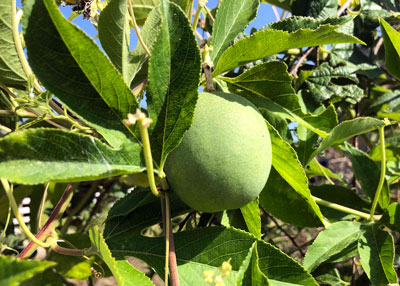Purple Passionvine Pleases
My wife and I had our grandson for a few hours this past weekend. He is all into museums, and if nature’s involved, that’s all the better. While I was doing my radio program on KLIF Saturday afternoon Lynn took him to the Heard Natural Science Museum in McKinney to see their butterflies, snakes and other animals. Perfect match!
Sunday after church he couldn’t wait to take me back to see a vine that had stolen his eye. It was a trumpetcreeper that seemed to be strangling a metal light post in the parking lot. But while we were there we looked around and I noticed this other absolutely beautiful vine.

I’ve loved passionvines all of my life. There was a big patch of them west of College Station where my dad did some of his research work for Texas A&M – out by the old Easterwood Airport. I used to love going out there with Dad just to look at their flowers. (The fact that he let me practice my driving had nothing to do with it.)
Passionvines and I go back that far. I’ve assembled some quick fun facts I can share with you about them.

Pertinent facts about passionvines…
• In genus Passiflora.
• This particular one is Passiflora incarnata. If the name sounds Biblical, I’ll come back to that later.
• Also known as “maypop” because if it’s growing on the ground, its mature fruit “may pop” loudly when you step on it.
• Assertive grower, it can quickly spread to 10 or 15 ft. tall and wide.
• Native to the eastern United States from Florida to the eastern half of Texas.
• Deciduous. May freeze to ground, but hardy to Zone 6.
• Does best with at least half a day of direct sun.
• Tolerant of a wide variety of soils.
• Tolerates heat and drought, but does well with moisture.
• Climbs by tendrils, but when there’s no support for it, it tumbles across the ground piling upon itself.
• Flowers 3 inches across.
• Fruit are hen-egg-sized, green at first, yellow when ripe.
• The preferred food source of beautiful Gulf Fritillary butterflies.
There are other Passiflora species and many hybrids in shades of purple, lavender, red and white, all equally stunning. This is one of the few really cold-hardy types. Most are tropical and must be brought into protection in winter when temperatures will drop very far below freezing.

Significance of the name and the flower…
The name “Passiflora” or passionvine, is credited to the flower parts’ representation of aspects of the crucifixion, or the Passion.
• The 5 petals and the 5 sepals represent the disciples of Jesus (excluding Peter and Judas).
• The 5 stamens represent the wounds Jesus received, 4 from the nails and 1 from the lance.
• The 3 stigmas represent the nails.
• The fringe represents the crown of thorns.
And so there you have the origin of the botanical name Passiflora incarnata, as explained by many Biblical references.
